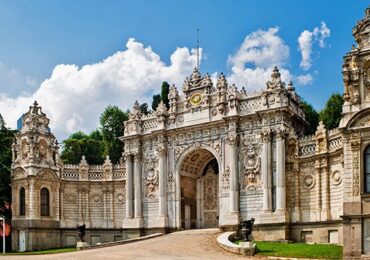Dolmabahçe Palace in Istanbul: Where Opulence Meets Ottoman Grandeur
Dolmabahçe Palace, an architectural masterpiece nestled along the Bosphorus shores in Istanbul, stands as a dazzling testament to the opulence and splendor of the Ottoman Empire’s later years. With its harmonious fusion of European and Ottoman architectural styles, this palace represents a fascinating chapter in Turkey’s history and a window into the lives of its rulers.

Regal Resplendence:
Dolmabahçe Palace served as the imperial residence for Ottoman sultans during the 19th century. It was built in a time when the empire sought to modernize and bridge Eastern and Western influences, which is reflected in the palace’s unique design.
European Elegance:
The palace’s façade exudes European elegance, characterized by neoclassical, baroque, and rococo elements. The ornate gates, grand staircases, and symmetrical gardens reflect the taste for grandeur that was prevalent in the 19th century.
Bosphorus Beauty:
Situated along the Bosphorus Strait, Dolmabahçe Palace boasts breathtaking waterfront views. The palace’s strategic location allowed Ottoman rulers to symbolize their control over key maritime routes and to showcase the empire’s presence on the global stage.
Grand Interiors:
Step inside the palace, and you’ll be transported to a world of lavish interiors. The opulent crystal chandeliers, gilded ceilings, and intricate marble work showcase the meticulous craftsmanship that went into creating this regal abode.
Crystal Staircase:
One of the most iconic features of Dolmabahçe Palace is the Crystal Staircase—a marvel of engineering and aesthetics. Adorned with crystal banisters, the staircase evokes a sense of enchantment as light refracts through the prisms.
Mustafa Kemal Atatürk:
Dolmabahçe Palace has significant historical importance as the place where Mustafa Kemal Atatürk, the founder of modern Turkey, resided during his visits to Istanbul. His room remains preserved as a museum, providing insight into his life and legacy.
Ceremonial Halls:
The palace’s ceremonial halls, such as the Ceremonial Hall of the Valide Sultan and the Ceremonial Hall of the Grand Vizier, were used for hosting dignitaries and state functions. Their grandeur speaks to the power and prestige of the Ottoman Empire.
Timeless Treasures:
Dolmabahçe Palace is not only a physical space but a repository of history. Its artifacts, furnishings, and artworks provide glimpses into the daily lives and tastes of the Ottoman elite.
Gardens and Clock Tower:
The palace’s lush gardens and the Dolmabahçe Clock Tower add to its charm. The clock tower, adorned with intricate ornamentation, stands as a symbol of the empire’s commitment to modernity.
Cultural Legacy:
Dolmabahçe Palace captures a unique period in Ottoman history when tradition met innovation. It serves as a reminder of the empire’s adaptability and the fascinating stories of those who shaped its destiny.
Step into a World of Regal Elegance and Ottoman Splendor: Dolmabahçe Palace—a Glimpse into the Lifestyles and Ambitions of a Bygone Era.
